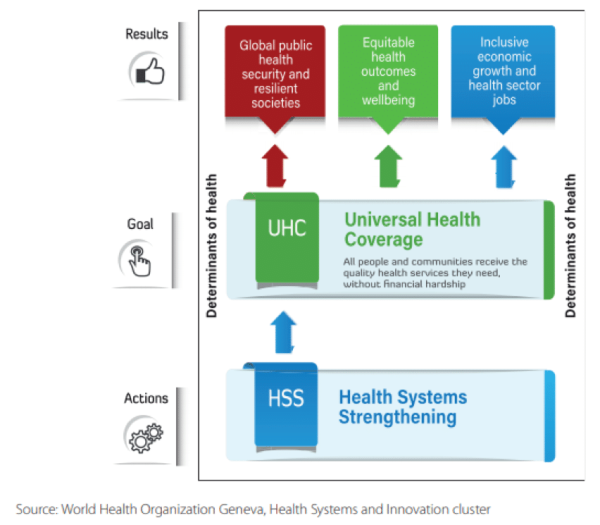World Health Organization Regional Office for Africa
The African Region has witnessed significant improvements in population health outcomes over the past two decades. However, these gains still fall short of global and regional targets and are not uniform across or within countries. The Region is also faced with major demographic, economic, epidemiologic, and socio-cultural transitions as well as health security and environmental threats which place greater demands on health systems. In response to these, and to guide Member States in strengthening their health systems towards achieving universal health coverage and the sustainable development goals, the WHO Regional Office for Africa has developed a framework of actions which builds on various prior frameworks.
It is rooted in an integrated approach to systems strengthening, a focus on communities and districts, and appropriate sequencing of actions for the best possible outcomes. The framework calls for investments in seven health systems input areas, and facilitates more pro-active results monitoring through four output areas and six outcomes that measure the impact on wellbeing for all.
Health systems strengthening for the SDGs and UHC
Health systems strengthening in the SDGs
The attainment of UHC, the overarching target that should facilitate achievement of all the other health targets in SDG 3, is directly concerned with the performance of the health system. A country is only able to provide the essential health and related services its people deserve if it has a functioning health system that can provide the services as and when needed.
Figure 1: Health systems strengthening, UHC and SDGs results

Interpreting health system strengthening for UHC
WHO has proposed an approach of prioritized emphasis based on countries contexts. It proposes three types of health systems interventions as a continuum based on each country’s context:
- i) Foundational: The health system lacks basic foundations needed to support provision of essential services. Health system strengthening efforts are therefore focused on making available the foundations of the system for delivery of essential services.
- ii) Institutional: The health system has the basic foundations, but lacks the appropriate institutional structure and mix needed to maximise health outcomes. Health system strengthening efforts are focused on the organization and alignment of the institutional structures and functioning, to improve delivery of essential services.
iii) Transformational: The health system has the basic foundations and institutional structures / mix. In this case, the health system strengthening efforts are focused on sustainability, exploring new ways of providing services that provide additional benefits, and supporting other countries whose systems are still in development.
Health system strengthening and UHC in Africa
This regional approach focuses on certain principles:
- Country and sub-national contexts and priorities appreciation as basis for inputs and actions
- A step-ladder approach to health systems improvement, using problem solving approaches and bottlenecks mitigation, to sequence investments and interventions
- Incorporate attention to emerging health challenges and risks (such as health security, climate change and NCD alerts) into designing systems that are sustainable
- Designing systems as e¡cient platforms for the provision of priority high impact interventions at district and community levels
The key elements for the African Region are:
- A primary emphasis on district and community health systems as the focus of health improvement actions, realigning the health system “building blocks” towards communities and families’ health
- Improving data generation, analysis and use to support primary health care (PHC) and UHC performance including
- services and care delivery according to basic packages of essential services
- risks assessments on disease burden (and potential risks burden)
- health promotion and preventive interventions to secure health
- attention to issues such as NCDs, climate change and new or renewed pathogens/ health security
- Improved governance, management and accountability at operational (districts) and community levels linked clearly to health service coverage and quality results
A framework of actions to achieve UHC and the SDGs
Domain 1
A health system requires a portfolio of investments in both hardware and software elements, to produce holistic system-wide performance and results. The following health systems investment areas, representing aspects of WHO building blocks, are fundamental action areas.
- Area (1) Health workforce: The range of actions needed to ensure motivated, productive and t-for-purpose health workers are available
- Area (2) Health infrastructure: presents the range of actions needed to ensure an appropriate infrastructure and logistics base exists
- Area (3) Medical products and health technologies: The range of actions needed to ensure the availability of the appropriate quality and quantity of medical products
- Area (4) Service delivery: presents the range of actions needed to ensure there is an appropriate system to ensure rational and effective delivery of essential interventions to improve and maintain health
- Area (5) Health governance: The range of actions needed to establish facilitative mechanisms for making policies, managing the sector and its units, and producing and accounting for results from health interventions
- Area (6) Health information, research and innovation: The range of actions needed to ensure that health systems interventions are based on appropriate information and evidence and utilize the most appropriate technology to improve health
- Area (7) Healthfinancing: The range of actions undertaken to ensure that health sector actions and interventions are appropriately financed to ensure the optimum provision of essential services and that these finances are efficiently managed
The relative importance and gaps in each area will vary according to each country’s context and resources. This will determine what types and levels of investments are needed to get the best results from their health system.
Domain 2
To ensure countries are focusing on comprehensive system performance planning and monitoring, four performance areas are defined that integrate the outputs from investments in the health system:
- Area (1) System resilience: the ability of the system to allow for continued provision of essential services even in the presence of internal or external shocks
- Area (2) Equity and efficiency of access: the ability of the system to overcome physical,financial, and/or sociocultural barriers that hinder utilization of essential services
- Area (3) Quality of care: the ability of the system to provide essential services that are person centred, effective and responsive to expectations
- Area (4) Service demand: the ability of the system to build the capacity of the communities to access and use essential services that are available
The monitoring of national health systems will utilize a common approach and index that reviews performance across these four result areas.
Domain 3
As previously highlighted, health is cross cutting, with direct health actions reflected in SDG 3 and indirect health related actions across the other SDGs. As a result, the population outcomes relating to improved coverage of key services and interventions needed for improving health are reflected across the SDGs. Six areas for service coverage outcome elements are proposed.
- Area (1) Essential services availability: Presence of essential health services as defined by the country.
- Area (2) Essential services coverage: Population utilizing the available essential health interventions.
- Area (3) Financial risk protection: Population protected from financial hardships arising from utilizing essential services.
- Area (4) Client satisfaction: Population satisfied with essential services/responsiveness to needs.
- Area (5) Health security: Population protected from preventable outbreaks, disasters and other health emergencies.
- Area (6) Health interventions in other SDGs: Population utilizing key cross-sector essential interventions that improve health.
Domain 4
SDG 3 – Healthy lives and wellbeing for all at all ages – is the overall health goal that countries in the African Region are committed to achieve by 2025. It represents the ultimate objective of all actions of the health and related sectors aimed at improving health. Achieving universal population coverage with key services and interventions across the six outcome areas should lead to the attainment of goal 3.
Three elements relate to this goal:
- Area (1) Life expectancy: Overall and disaggregated measure of expectation of life in the country. is can be through looking at the life expectancy (at birth, or at specific ages), and/or the healthy life expectancy (HALE) that discounts life expectancy for time spent unwell / with disease disabilities.
- Area (2) Morbidity and mortality reduction: The reductions seen in the major causes of ill health and death in the country. This is looked at through monitoring trends with
- Top causes of disease burden in the country from disease burden studies
- Mortality trends overall (total mortality) for specific conditions (such as HIV, Malaria, NCDs, etc.) and cohorts (infant, maternal, child, adolescent, adult)
- Incidence and prevalence tends overall and for specific conditions of concern in the country
- Area (3) Risk factors reduction: The reduction in incidence of key risk factors associated with current or future health threats. This relates to:
- Behavioural risk factors such as physical (in)activity, substance abuse and others
- Environmental risk factors such as noise and particle pollution
- Metabolic risk factors such as high blood pressure, high blood sugar and others
Roles and responsibilities in actualising the framework
Supporting HSS for UHC and the SDGs will require the engagement of a spectrum of stakeholders and actors within and outside the health sector.
- Ministries of health need to provide stewardship of this process. They should bring together stakeholders in the country, and coordinate the process of interrogation of actions guided by the revised planning and monitoring guidelines.
- Other government sectors and actors need to be oriented on choices made and why, particularly on the health-related intersectoral actions that support the interventions identifi
- Communities and populations are the beneficiaries of an effective health sector and whose cooperation is essential for the effectiveness of interventions
- Non-state actors in the country (NGOs, CSOs, and others) aligned around common priorities identified by the country and owned by its citizens, avoiding external partner-driven priorities
- External/international actors – Global Health Initiatives, multilateral institutions and agencies, bilateral cooperation agencies, (sub) regional institutions, private philanthropic foundations that fund, advise and facilitate actions on health development interventions.
To achieve the key performance objectives, health system strengthening is best supported through a holistic approach. Projects that focus on specific health systems building blocks in isolation do not result in robust, resilient and responsive health services.
Les Wathinotes sont soit des résumés de publications sélectionnées par WATHI, conformes aux résumés originaux, soit des versions modifiées des résumés originaux, soit des extraits choisis par WATHI compte tenu de leur pertinence par rapport au thème du Débat. Lorsque les publications et leurs résumés ne sont disponibles qu’en français ou en anglais, WATHI se charge de la traduction des extraits choisis dans l’autre langue. Toutes les Wathinotes renvoient aux publications originales et intégrales qui ne sont pas hébergées par le site de WATHI, et sont destinées à promouvoir la lecture de ces documents, fruit du travail de recherche d’universitaires et d’experts.
The Wathinotes are either original abstracts of publications selected by WATHI, modified original summaries or publication quotes selected for their relevance for the theme of the Debate. When publications and abstracts are only available either in French or in English, the translation is done by WATHI. All the Wathinotes link to the original and integral publications that are not hosted on the WATHI website. WATHI participates to the promotion of these documents that have been written by university professors and experts.
